“You are missing a ‘c’ in the crab cake”, you could say. But no, Rab cake is not your favorite summer seafood patty! I’m talking about something radically different: a sweet delicacy from Rab, a picturesque island in Northern Adriatic. If you want to discover the culinary heritage of Croatia, the centuries-old almond dessert locally known as rapska torta is a perfect first bite.
Rab cake was considered so sacred and special that its recipe has been kept secret, almost like a relic, behind the thick walls of the local abbey for centuries
I traveled to Kvarner Gulf, where Rab has been known as the Happy Island since Roman times. This was the birthplace of Saint Marinus, the founder of San Marino, but also the place that pioneered naturism, with the audacious King Edward VIII making headlines by embracing skinny-dipping.
However, a delectable treat of rapska torta, born in the medieval city-state thanks to an unexpected pope visit, is the most illustrious product of Rab that should convince you to include the island in your Dalmatian itinerary.
Not every cake can boast of receiving the honor of approval by the pope himself. Rab’s unique pastry, crafted by skilled hands in the local nunnery, holds that distinction.
The cake was considered so sacred and special, almost as the skull of St Christopher, the patron saint of travelers, housed in the local Church of Saint Justine, that its secret was equally shielded with devotion and protected as a treasure for centuries.
Well, the mystical veil gets lifted today, as we explore Rab cake’s origins, reveal the ingredients and recipe of this heavenly treat, and expose the secrets behind the mouthwatering flavors that delighted generations of Croatians. Indulge in rapska torta, the cake that puts a smile in the Happy Island!
Kuća rabske torte – the home of the melted ‘b’
The most eager ambassador in promoting Rab cake is called Kuća rabske torte. For a decade now, nestled in the heart of Rab’s Old Town, this charming museum-meets-temple is dedicated to the island’s most famous dessert. Their employees tirelessly knead the cake dough and sculpt the scrumptious filling into traditional spiral forms. The culinary sanctuary could have the fastest bakers handcrafting the snail-shaped sweet, but those eager tourists’ mouths are even quicker.
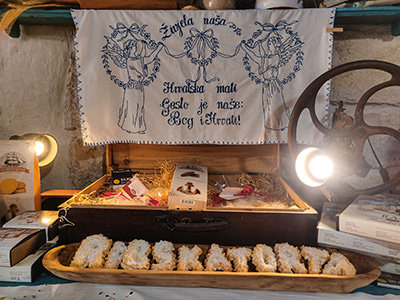
But wait a minute. Why is this establishment called Kuća rabske torte when the cake it produces goes by the name rapska torta? I can see the confusion in your eyes. The Croatian language is not the easiest to master, and even when scholars defend the principles of natural speech, the realities of everyday life don’t always conform to those neat linguistic rules.
So if the island is called Rab, should the cake from Rab be referred to as rabska torta or rapska torta? According to the rule of equalization of consonants by sonority, the correct name is rapska torta. But at the same time, we can see that the main institution promoting the island’s tastiest souvenir calls it rabska torta. Even the local and national tourist offices disregard the rule that changes ‘b’ into ‘p’ in front of ‘s’, ignoring the difficulty of pronunciation. For the sake of this article, we will stick with the linguistically sound version – rapska torta, even if this report was made at Kuća rabske torte.
With a full mouth, nobody cares about strict lingual laws. When the scrumptious combination of velvety almonds, zesty citrus, and cherry liqueur crosses our lips and makes our taste buds dance, the bilabial consonant ‘b’ melts in the sound of munching. It’s summer, rules take a vacation too, and everything is forgiven.
Vilma Brna – the woman behind rapska torta revival
Rapska torta is not the easiest to make and it’s even harder to perfect. It demands precision, skill, determination, and a pinch of culinary magic. Just like many other complex cakes, rapska torta is a labor of love.
It was exactly love that brought confectioner Vilma Brna to the island in the groovy 1970s. The man who stole her heart was a local waiter who would later become her husband.
Vilma began creating desserts for the esteemed Hotel Imperial, but her sweet ambitions were bigger than that.
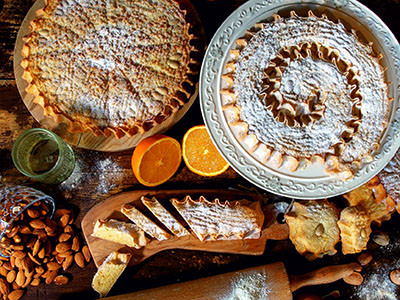
In 1996, she decided to take a leap of faith and open her very own bakery. In a time when only nuns were known for making the Rab cake, Vilma managed to learn its secrets and brought the heavenly treat to the non-religious masses.
Ten years later, Vilma would officially retire, but her Vilma Slastice company would continue on with a new leader. The confectioner passed the whisk to her son, the ambitious chef Josip Brna.
In 2015, a new chapter of the dream unfolded as Josip introduced the House of Rab cake – Kuća rabske torte. He expanded the empire, offering an array of cookies, treats, and eventually even their very own gin.
What started as a one-woman-show, blossomed into a sweet factory employing around 30 people, and raking in a yearly revenue of 1.1 million euros.
Busy bees at Kuća rabske torte
Kuća rapske torte is an authentic place, somewhere between a shop and a workshop. On Ulica Stjepana Radića, right next to the city lodge, I’m greeted by an ever-attentive host, Marinko. It’s always refreshing to step into a place adorned with a genuine smile. I did my part in the service industry, so I know that friendliness is hard to fake, especially in a job that’s a magnet for both wandering passers-by and organized tourist groups all longing to witness the making of Rab cake.
Amidst the constant stream of visitors, Marinko casually tells me his son’s name is Ivan too. And as I open the topic of my upcoming birthday, and the idea of buying their product as a birthday cake, he confesses his son was actually born on the day of my visit, yet he hasn’t managed to find a spare moment to give him a call. Selling Rab cake requires dedicated attention. Even the siren call of the nearby sea, begging for a refreshing dip, must be ignored during the bustling peak season.
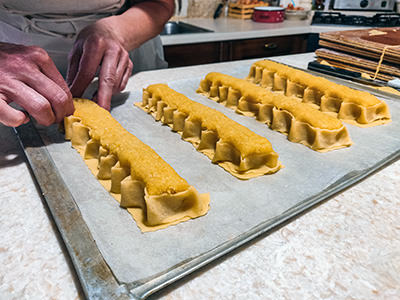
When Ružica Ribarić comes to work, her hands don’t stop. Rab cake doesn’t just magically appear out of thin air, after all. “My personal record was 196 cakes in one day”, Ružica tells me, with a smile that could rival Usain Bolt‘s.
“As a matter of fact, we don’t manage to make as many as the sale demands. Here, in front of guests, it’s me in production, but we also have our central pastry shop where we produce Rab cake and all our other cookies too. Yet, there never seems to be enough of us.”
Rab cake history – satisfying the pope’s palate
The cultural significance of rapska torta is based in its history. The origins of Rab cake are in the 12th-century Benedict recipe as, according to the legend, it all started with one unexpected visitor to the island.

It was 1177, and Pope Alexander III and his entourage of ten mighty galleys were returning from the episcopal synod to Italy when a heavy storm hit the Northern Adriatic.
“He actually had to travel from Zadar to Venice, but as the weather was bad, he sheltered in our town’s harbor”, Ružica retells me the story as she deftly cracks the eggs for the cake.
Coincidentally with the arrival of the pontiff and his crew in the welcoming haven, the people of Rab had just completed the renovations of their Cathedral of the Assumption of Mary. It was an opportune moment for the pope to bless their church.
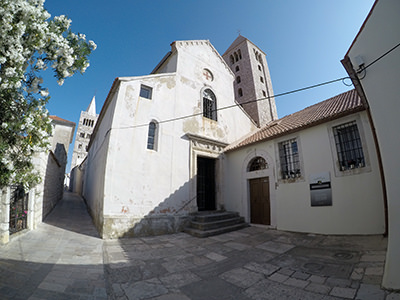
The Benedictine nuns from the Abbey of Saint Andrew set out to surprise the esteemed guest. To express their respect and gratitude, they crafted a divine cake carefully selecting the flavors reminiscent of the traditional sweets of Siena, the pope’s birthplace in Italy. While there is a theory that Arab sweets inspired the creation of the famous ricciarelli di Siena in the 14th century, the similarity in ingredients between the macaroon biscuits and Rab cake might suggest that inspiration arrived even earlier, with the pope.
Rab cake continued to be perceived as precious, becoming the darling of noble palates during Venetian rule. Considered the food of the wealthy elite (the poor actually mimicked the cake with humble pine nuts instead of almonds), rapska torta ascended to the throne of ultimate cake for holidays and special occasions. Even today, baptisms, first communions, confirmations, and weddings on Rab are religious sacraments that would be deemed blasphemy without the presence of rapska torta.
Rab cake ingredients
Originally made on communion wafers, the key ingredients of Rab cake were almonds and eggs. According to Ružica, whose name itself translates to ‘little rose’ in Croatian, the original Rab cake recipe from the 12th to 16th century featured a splash of rose liqueur. “Later, Franciscans brought maraschino cherry liqueur from Zadar, and since the 16th century, maraschino was used.”
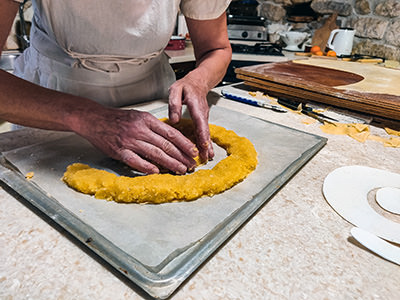
In the old days, when the world was a little less connected, gastronomies celebrated all things local. So even Rab cake was made with ingredients that were readily available on the island back then.
“Before, Rab Island had really a lot of almonds. As Punta Luna on the island of Pag was also under Rab’s jurisdiction, our ancestors were planting almonds there too. That’s why our cake’s crucial ingredient is almond”, Ružica explains.
“As the climate changed, sadly we don’t have almonds on the island anymore. We manage to bring it in from the other parts of Dalmatia, near Benkovac and Zadar, but the rest comes from anywhere where we can get it, depending on the demand. Luckily, citrus fruits successfully grow on Rab, so we do have our own oranges, tangerines, and so on.”
And that’s the backbone of the flavor profile of Rab cake: the alchemical blend of almonds, lemon/orange zest, and cherry liqueur.
Unlike other available online recipes, Ružica reveals that she puts butter into the filling. It’s a little twist that elevates the indulgence factor and makes each slice even more irresistible.
Rab cake recipe – decoding the delicious
“Until a hundred years ago, it was unthinkable to get your hands on the recipe for Rab cake. The cake was made primarily by Benedictine nuns, and a few women here in the Old Town, but they also kept the recipe, they didn’t like to give it away”, Ružica says.
If you dare to crack the rapska torta’s secret code by consulting the “all-knowing” AI models of today, despite their enormous data pool, they will typically just spew out some blathering that won’t get you far. That’s how well the secret was hidden.
Keeping the Rab cake recipe out of the sight of even neighboring villages was considered a matter of prestige. But the most tightly sealed lips eventually did part ways, and the longest-guarded town secret spilled into secular kitchens, where the divinity of the dessert could be achieved by anyone who approached it with hallowed commitment.
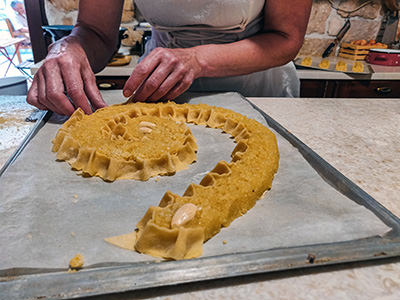
“That’s right, the elderly ladies who were regularly going to church, made friends with the nuns, and eventually they got their hands on Rab cake recipe”, Ružica tells me. “But while the nuns preserved the recipe from oblivion, written on a piece of paper with calligraphy, it only reveals the ingredients, without measures. So the secret still exists. We have to achieve the result we want on our own. You have to make rapska torta at least 100 times to get it right. Because the ingredients must be felt under fingers.”
Basically, making this treat is a dance between intuition and experience. The Rab cake recipe can even hardly be put into words. Still, to cut your journey of trial and error, we’ll give it a go here!
How to make rapska torta: A step-by-step guide, from preparation to serving
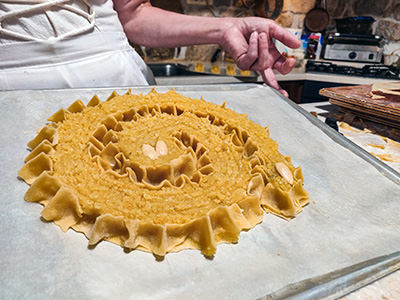
For the crust:
– ½ kilo flour
– 8 eggs
– water
– salt
– sugar
– maraschino liqueur
For the filling:
– 2 kilos almonds
– 2 kilos sugar
– 12 eggs
– ½ kilo butter
– 2 dcl marachino liqueur
– peel from 6 lemons and 2 oranges
Steps for making Rab cake
- The first step has to be made a couple of days before you want to bake the cake. Blanch the almonds in boiling water for 10 minutes, peel off their skins, and let them dry at room temperature for 2-3 days.
- The second step – the making of the dough – should be done a day before you want to bake the cake. It’s similar to pasta dough, but with a twist of sugar and maraschino liqueur, for that aromatic touch. After you knead the dough by hand (just like everything is done by hand in this recipe), let it rest overnight in the fridge. That will make it easier for tomorrow’s work.
- On the big day of baking, half of the work is already done. Roll out the dough, and let it dry a bit, as that will enable easier lacing (creating the decorative mold for our filling). The dough should be really thin. Remember, long ago, the cake base was sacramental bread, the one Christians consume during the Eucharist. So your dough has to be as thin as a wafer.
- Grind the dried almonds.
- Combine the ground almonds, sugar, melted butter, citrus peel, eggs, and a good cup of liqueur. If you cannot get your hands on maraschino cherry distillate, you can experiment with something similar. Mix by hand until compact. The mixture should not be too hard, nor too soft, just right.
- Place the rolled-out dough on flour-dusted parchment paper, on an oven tray. Cut the dough base into your desired shape (you can use a paper form to guide you). The traditional shape is the one of the snail’s shell, but it could be just a regular bar (baštun), a heart, a horseshoe, letters, numbers, or anything you imagine.
- The filling mixture should be compact and sticky enough to be shaped in any desired form. Place the filling on your dough base, and shape it nicely.
- Use a fork to gently rake the top of the placed filling, for aesthetics.
- If you want to additionally decorate your cake, you can place whole almonds on top of the mixture, marking the beginning and the end of the cake.
- Cut out the dough ribbons, some 1,5 cm in width, and use them to lace the sides of the cake. The process consists of gently pressing the dough strips towards the almond mixture, creating little ruffles, as well as towards the bottom base, so it all connects and holds together during the baking.
- Preheat your oven to 150 degrees Celsius, and let the cake bake for 20 minutes.
- When the cake cools down, you can dust it with powdered sugar, decorate it with Bianca Neve flowers, or even serve it on a lace napkin. Pair it with a cup of coffee or tea, but a shot of maraschino will also do.
As they would say in Croatian, dobar tek! Bon appétit!
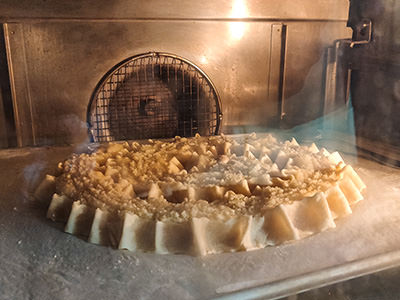
Cake whisperer’s tips and tricks
- The amounts of ingredients in this recipe may seem like a cake army but fear not, and adjust them to fit your needs. For instance, a snail-shaped cake requires half a kilo of filling. So go ahead and play with the proportions!
- Using high-quality ingredients is key. Always blanch the almonds by yourself, as pre-peeled almonds from the supermarket may not produce the desired result.
- While Rab cake can be eaten warm, it is actually a cold cookie. Its shelf life is two months, as its abundant sugar content acts as a preservative. Remember, this is a millennium-old recipe, from the times when there were no refrigerators or electricity.
- Do everything by hand. Temperatures and moisture vary in summer and winter, and you may need to adjust your ingredients, either by adding more eggs (in cold months) or more almonds (in warm months). One gets the feeling for it by doing it, that’s why it’s important to use your fingers, as well as make a hundred Rab cakes before you master the craft.
If you still need support in making your cake, check out how Ružica does it in our rapska torta video recipe!
The experience of Rab cake
If you followed my sugar rush from Korean desserts in Seoul to Hungarian desserts in Budapest, you may already know I’m a vulnerable sweet tooth.
On paper, rapska torta reads like a sugar avalanche, but it’s surprising how its balanced flavors hit your tongue, and it doesn’t feel overtly sweet at all. I am actually somewhat disturbed, as when you enter Kuća rapske torte, controlling yourself while tasting free samples is an incredibly hard task.
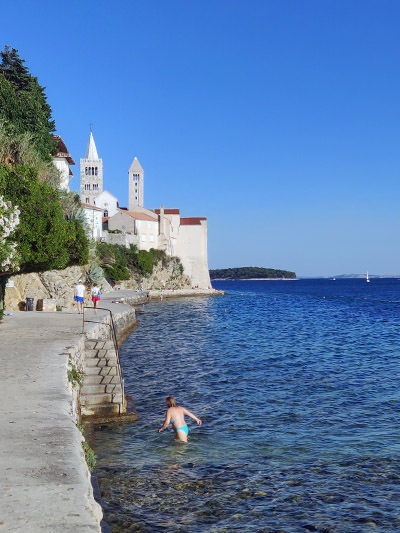
During my visit, I see tourists dropping in, equally captivated, with eyes wide open, and mouths salivating at sight. Sometimes, it’s not convenient for them to buy the cake, as they are heading to the beach, but that doesn’t stop them from entering and tasting samples, with a promise they will purchase the cake before leaving Rab.
Delightfully light and airy, this subtle bite from the Happy Island provides a harmonious mouthfeel. As comfort food, it embodies the warmth of Croatian cuisine. While it springs off from Benedictine nuns and gets celebrated as the centerpiece of Christian festivities on Rab, rapska torta is so devilishly good that most non-religious souls could equally surrender to this temptation. Resistance is futile.
Rab cake is not only a symbol of the island of Rab. Its cultural significance and contribution to local identity were also recognized and protected as national cultural heritage. The art of preparation of rapska torta, that’s orally passed down through generations and can be tracked to at least the 18th century, has been included in the Register of Cultural Goods of the Republic of Croatia, under the label Z-7348. It’s not just a cake; it’s a slice of history.
Rapska torta price – sweetness in every size
At Kuća rabske torte, one can find Rab cakes of various sizes and shapes. Rapska torta price depends on your cravings, and any desire will get an offer.
If you’re seeking a bite-sized souvenir, the round 40-gram cake costs 5 euros, and 100-gram – 7.10 euros. These are perfect for a quick indulgence.
The most popular among the buyers, however, is the 200-gram Rab cake, shaped like a petite bar. Wrapped in cellophane, it costs 10.80 euros, and if you want it in a cardboard box, the price will be 11.60.
For the adventurous souls who crave a grand experience, there are XXL Rab cakes in the traditional spiral form. The half-kilo cake is priced at 26.94 euros, and the kilo cake – 47.70 euros.
If you want the most special Rab cake, the generous 400-gram heart can be yours for the irresistible price of 19.80 euros.
From abbey to airport: Where to buy rapska torta?
The very best Rab cake is produced at Kuća rapske torte, which is open to visitors from 10 am till midnight every day.
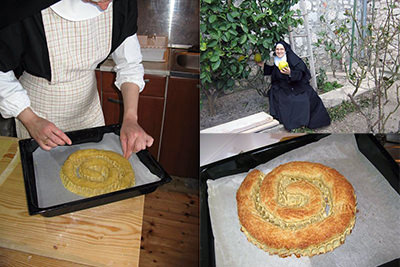
If you want the most authentic cake, you should head to the creators themselves – the Benedictine Abbey of St. Andrew. The nuns’ shop is open Monday through Saturday in the morning hours (9 am – 2 pm), and Monday through Thursday in the evening hours (6 – 8 pm). Besides the cake, here you’ll find a cornucopia of wonders: healing tinctures and ointments, jams, liqueurs, and even massage oils. The Rab cake made by Benedictine nuns costs 7.30 euros (200 g).
Rapska torta can also be bought at many local pastry shops, souvenir havens, restaurants, and hotels.
If by some twist of fate, you miss them all, you could score your Rab cake at duty-free shops in Croatian airports, as your last resort before leaving the country.
Where to stay in Rab?
Now, the crucial question of where to rest your weary head after indulging in the delightful world of Rab cake. Here are some accommodation options that will perfectly complement your sweet adventures. For those with a taste for refined elegance and a penchant for historic grandeur, look no further than Arbiana Heritage Hotel. Nestled along the seafront, this beauty from the opulent era of the Austrian-Hungarian Empire offers 4-star rooms starting at 123 euros per night in the off-season, and 300 euros at its peak. Slightly more affordable, but not compromising on comfort, is the 3-star Hotel International, where Vilma Brna started her sweet Rab journey. A room here can cost between 120 and 189 euros per night, depending on the season. I stayed at private accommodation in nearby Palit. Guest House Violeta is operated by a genuinely warm and supportive family, and you can get a room there for 50 to 100 euros per night. That price will allow you to save some dough for extra slices of Rab cake.
Rapska torta, a cake fit for a pope – Conclusion
Rab cake or rapska torta (or even rabska torta, if you insist) is a culinary superstar of Rab that showcases the rich cultural heritage of Croatia, and the country’s dedication to preserving traditional recipes.
Its unique blend of local fragrant flavors (from citrus fruits and almonds to renowned liqueur from the Zadar region), with its delicate execution, make it a truly unforgettable dessert.
Rapska torta is a reason enough to travel to Rab and loosen that belt buckle
Even if described as a “dry cake” with a long shelf life, Rab cake’s mouthwatering taste and texture regularly surprises everyone who tries it. It’s a struggle to take just one bite of this unique cake tart.
From its humble beginnings on the island of Rab, where its absence from any celebration could provoke a curse, to its revered status as a protected cultural treasure, this traditional cake has endured the test of time and continues to entice food lovers worldwide.
Rapska torta is a reason enough to travel to Rab, loosen that belt buckle, and discover Croatia’s legacy compressed into a single dessert perfected through centuries.
If Rab cake’s recipe was worth all the trouble of guarding it as a top-secret, and passing it down by word of mouth through Croatian family trees (because what’s whispered and not written down can hardly be stolen), it has to stand for something.
Guarded by the sisters of the church, behind the thick walls of Rab town, with practically the status of a holy relic, the culinary masterpiece exposed something deemed impossible. Even decadence can find its place in Pope-approved reverence.
Have we awaken your appetite for Rab cake?
Pin this article for later!
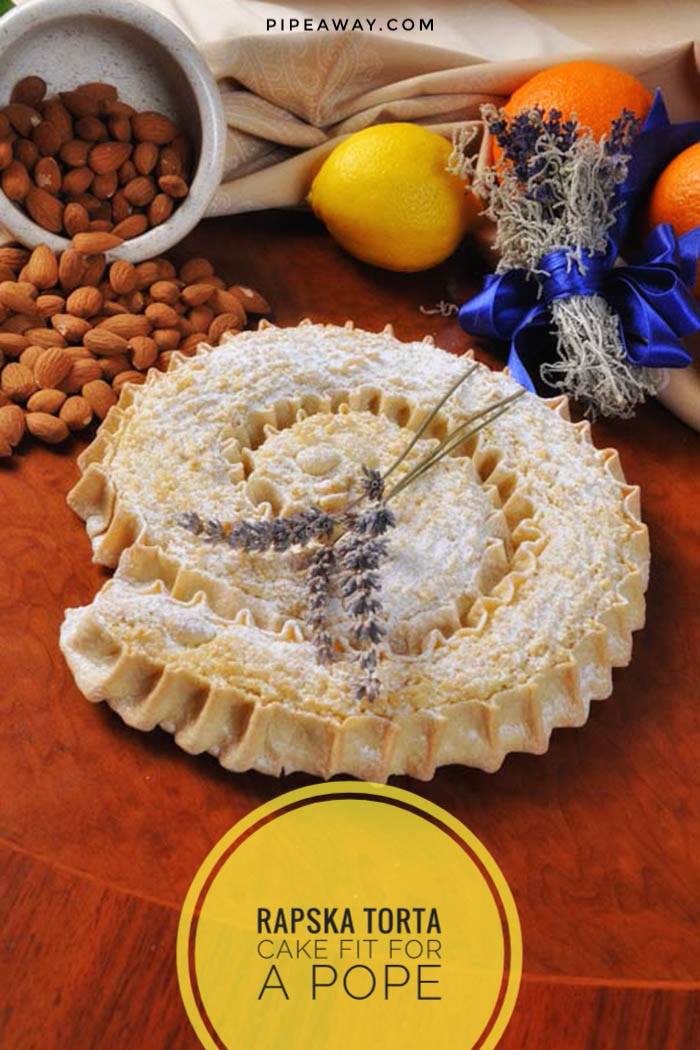
Disclosure: This post may contain affiliate links, meaning if you click on them and make a purchase, Pipeaway may make a small commission, at no additional cost to you. Thank you for supporting our work!

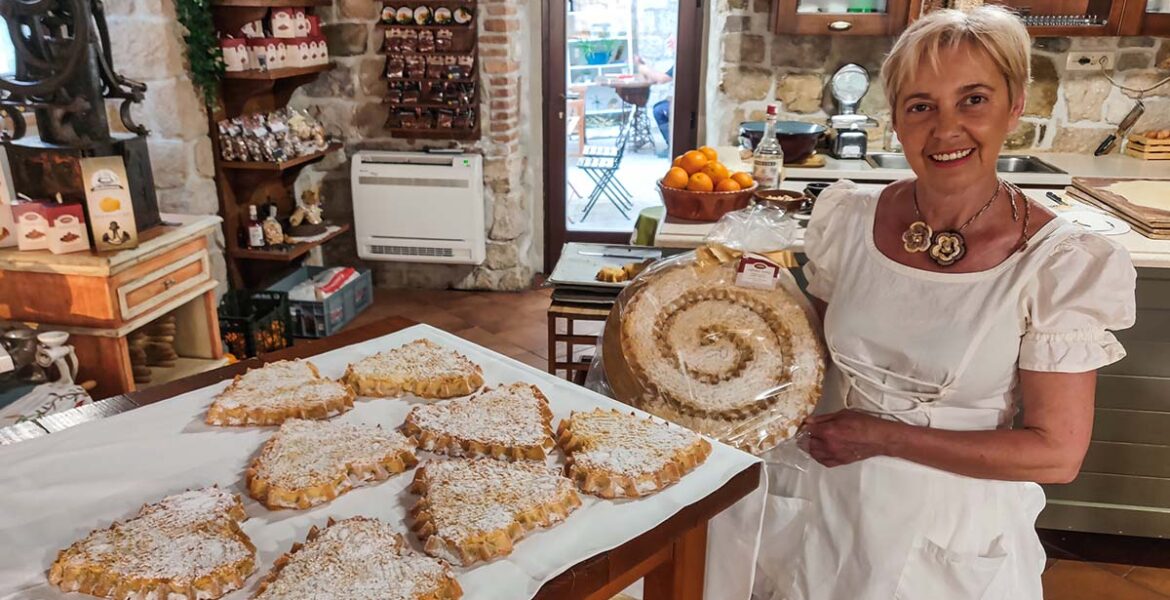


I have not heard of a rab cake before reading your post. Truly fascinating history and I now have it on my Croatia list. I love almond and cherry flavors!
Rab cake is definitely a hidden gem of Croatian cuisine, and the blend of almond and cherry flavors is a true delight.
Adding it to your Croatia list is a fantastic idea, Heather!
Enjoy your slice when you get there! I’m sure you’ll find it mouthwatering!
I had not heard of Rab cake, but it sounds delicious!! If I find one in Rijeka, I will definitely try it!
I’m glad that Rab cake piqued your interest, Darla!
While Rab is the place of its origin, you might just find this delicious dessert in Rijeka or other parts of Croatia.
If you do come across it, be sure to give it a try. Savor every bite!
Pastry art! Out of my baking comfort zone, but what a fun video to watch and I learned a new way to crack eggs!
Alexa, I’m glad you enjoyed the video!
I had to rewatch it to see the egg cracking, as it seems it slipped my conscious attention.
I’ve never tried cracking eggs like that myself either, but I could give it a try the next time I need them.
Probably also for something less demanding than Rab cake 😉